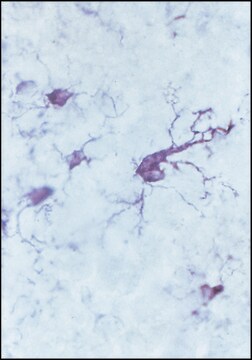F6136
Anti-Horse Spleen Ferritin antibody produced in rabbit
affinity isolated antibody, lyophilized powder
Synonym(s):
Ferritin Antibody
Sign Into View Organizational & Contract Pricing
All Photos(1)
About This Item
Recommended Products
biological source
rabbit
conjugate
unconjugated
antibody form
affinity isolated antibody
antibody product type
primary antibodies
clone
polyclonal
form
lyophilized powder
species reactivity
horse
technique(s)
immunoelectrophoresis: suitable
immunoelectrophoresis: suitable
indirect ELISA: 1:10,000
storage temp.
2-8°C
target post-translational modification
unmodified
Gene Information
horse ... Ftl(100051593)
Looking for similar products? Visit Product Comparison Guide
General description
Ferritin consists of homogenous protein segment called as apoprotein and an iron segment which binds to the apoprotein. It is composed of heavy (H) and light (L) chains.
Ferritin is the storage form of iron in mammals, found mainly in liver, bone marrow and spleen. It is also present in small intestine, placenta, kidney and heart. Horse spleen ferritin is made up of 24 identical subunits. Ferritin of different organs is distinct with different electrophoretic mobility and possible functional differences.
.
.
Specificity
The antibody specifically recognizes ferritin from horse spleen.
Immunogen
Purified horse spleen ferritin
Application
Anti-Horse Spleen Ferritin antibody was used for immunocytochemistry of rat brain sections at a working antibody dilution of 1:2000 and in mouse brain sections at 1:1000. The antibody was used for immunoblotting using cell lysates of mouse primary erythroblasts and human ovarian carcinoma cells and human bronchial epithelial cells at a working dilution of 1:1000. The antibody is suitable for immunoelectrophoresis.
Horse Spleen Ferritin antibody has been used:
- immunofluorescence
- in western blotting
- in immunohistochemistry
Biochem/physiol Actions
Ferritin iron is oxidized from Fe(II) to Fe(III) in the presence of the enzyme ferroxidase.
Physical form
Lyophilized from 0.01 M sodium phosphate, 0.015 M sodium chloride, pH 7.2
Reconstitution
Reconstitute with 0.135 M sodium chloride.
Disclaimer
Unless otherwise stated in our catalog or other company documentation accompanying the product(s), our products are intended for research use only and are not to be used for any other purpose, which includes but is not limited to, unauthorized commercial uses, in vitro diagnostic uses, ex vivo or in vivo therapeutic uses or any type of consumption or application to humans or animals.
Not finding the right product?
Try our Product Selector Tool.
Storage Class Code
11 - Combustible Solids
WGK
WGK 2
Flash Point(F)
Not applicable
Flash Point(C)
Not applicable
Personal Protective Equipment
dust mask type N95 (US), Eyeshields, Gloves
Choose from one of the most recent versions:
Already Own This Product?
Find documentation for the products that you have recently purchased in the Document Library.
Transferrin ensures survival of ovarian carcinoma cells when apoptosis is induced by TNF$\alpha$, FasL, TRAIL, or Myc
Fassl S, et al.
Oncogene, 22(51), 8343-8343 (2003)
Jan A Gorter et al.
Epilepsia, 46(9), 1371-1379 (2005-09-09)
Iron accumulation in the brain has been associated with neurodegenerative disorders, including epilepsy. In our previous SAGE study, we showed that ferritin, an iron-storage protein, was one of the genes (Ferritin-H) that showed overexpression before the chronic epileptic phase. In
New functions for an iron storage protein: the role of ferritin in immunity and autoimmunity
Recalcati S, et al.
Journal of Autoimmunity, 30(1-2), 84-89 (2008)
Microglial pathology in Down syndrome
Xue Q S and Streit W J
Acta Neuropathologica, 122(4), 455-455 (2011)
Structure and physiological functions of ferritin
Granick, S
Physiological Reviews, 31(4), 489-511 (1951)
Our team of scientists has experience in all areas of research including Life Science, Material Science, Chemical Synthesis, Chromatography, Analytical and many others.
Contact Technical Service







